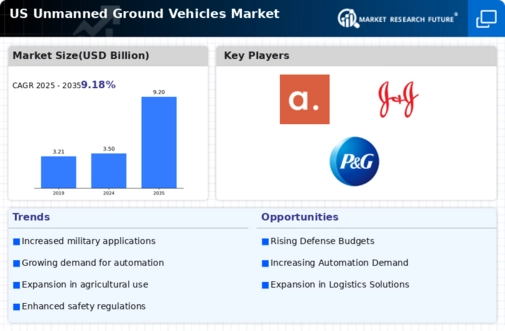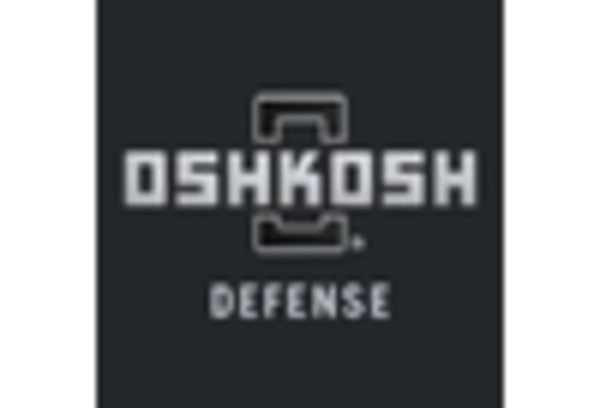Increased Defense Spending
The unmanned ground-vehicles market is experiencing a surge in demand due to increased defense spending by the US government. In recent years, the Department of Defense has allocated substantial budgets for the development and procurement of advanced unmanned systems. For instance, the fiscal year 2025 budget request includes over $1 billion dedicated to unmanned systems, indicating a strong commitment to enhancing military capabilities. This financial backing is likely to drive innovation and production within the unmanned ground-vehicles market, as military applications continue to expand. The focus on unmanned systems is not only limited to combat scenarios but also extends to logistics and reconnaissance, further broadening the market's potential. As defense budgets grow, the unmanned ground-vehicles market is poised for significant growth, attracting investments and fostering technological advancements.
Growing Demand for Automation
The unmanned ground-vehicles market is witnessing a growing demand for automation across various sectors, including agriculture, construction, and logistics. As industries seek to enhance efficiency and reduce operational costs, the adoption of unmanned ground vehicles is becoming increasingly prevalent. For example, in agriculture, unmanned ground vehicles are utilized for tasks such as planting, harvesting, and monitoring crops, leading to improved productivity. The market is projected to grow at a CAGR of approximately 15% from 2025 to 2030, driven by the need for automated solutions. This trend indicates a shift towards integrating unmanned systems into everyday operations, thereby expanding the market's reach. As businesses recognize the benefits of automation, the unmanned ground-vehicles market is likely to flourish, presenting opportunities for manufacturers and technology providers.
Advancements in AI and Robotics
The unmanned ground-vehicles market is significantly influenced by advancements in artificial intelligence (AI) and robotics. These technologies are enhancing the capabilities of unmanned systems, enabling them to perform complex tasks with greater autonomy and precision. For instance, AI algorithms are being integrated into unmanned ground vehicles to improve navigation, obstacle detection, and decision-making processes. This integration is expected to lead to a more efficient and reliable operation of unmanned systems. The market is projected to reach a valuation of $5 billion by 2030, driven by these technological innovations. As AI and robotics continue to evolve, the unmanned ground-vehicles market is likely to see an influx of new applications and use cases, further solidifying its position in various industries.
Increased Focus on Safety and Security
The unmanned ground-vehicles market is benefiting from an increased focus on safety and security across various sectors. Organizations are recognizing the potential of unmanned systems to enhance safety by performing hazardous tasks without putting human lives at risk. For example, in construction and mining, unmanned ground vehicles can be deployed in dangerous environments, reducing the likelihood of accidents. This emphasis on safety is driving investments in unmanned technologies, with the market projected to grow at a CAGR of 12% over the next five years. As safety regulations become more stringent, the demand for unmanned ground vehicles is likely to rise, further propelling the market forward. The integration of advanced safety features in these systems is expected to enhance their appeal and adoption across industries.
Rising Interest in Urban Mobility Solutions
The unmanned ground-vehicles market is increasingly being shaped by the rising interest in urban mobility solutions. As cities grapple with congestion and pollution, there is a growing push for innovative transportation alternatives. Unmanned ground vehicles, such as autonomous delivery robots and shuttles, are being explored as viable solutions to address these urban challenges. The market for autonomous delivery services is expected to grow significantly, with estimates suggesting a potential market size of $10 billion by 2030. This trend indicates a shift towards integrating unmanned systems into urban infrastructure, enhancing mobility and accessibility. As urban areas continue to evolve, the unmanned ground-vehicles market is likely to play a crucial role in shaping the future of transportation.

















Leave a Comment